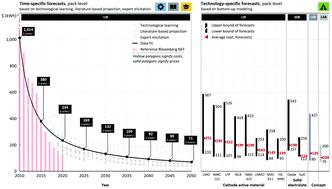当前位置:
X-MOL 学术
›
Energy Environ. Sci.
›
论文详情
Our official English website, www.x-mol.net, welcomes your feedback! (Note: you will need to create a separate account there.)
Battery cost forecasting: a review of methods and results with an outlook to 2050
Energy & Environmental Science ( IF 32.5 ) Pub Date : 2021-08-02 , DOI: 10.1039/d1ee01530c Lukas Mauler 1, 2 , Fabian Duffner 1, 2 , Wolfgang G. Zeier 3, 4 , Jens Leker 1, 4
Energy & Environmental Science ( IF 32.5 ) Pub Date : 2021-08-02 , DOI: 10.1039/d1ee01530c Lukas Mauler 1, 2 , Fabian Duffner 1, 2 , Wolfgang G. Zeier 3, 4 , Jens Leker 1, 4
Affiliation

|
Rechargeable batteries are a key enabler to achieve the long-term goal to transform into a climate-neutral society. Within this transformation, battery costs are considered a main hurdle for the market-breakthrough of battery-powered products. Encouraged by this, various studies have been published attempting to predict these, providing the reader with a large variance of forecasted cost that results from differences in methods and assumptions. This article creates transparency by identifying 53 studies that provide time- or technology-specific estimates for lithium-ion, solid-state, lithium–sulfur and lithium–air batteries among more than 2000 publications related to the topic. The relevant publications are clustered according to four applied forecasting methods: technological learning, literature-based projections, expert elicitations and bottom-up modeling. Method-specific assumptions are analyzed in-depth and discussed with regard to their results and empirical evidence. Further, 360 extracted data points are consolidated into a pack cost trajectory that reaches a level of about 70 $ (kW h)−1 in 2050, and 12 technology-specific forecast ranges that indicate cost potentials below 90 $ (kW h)−1 for advanced lithium-ion and 70 $ (kW h)−1 for lithium-metal based batteries. Recent studies show confidence in a more stable battery market growth and, across time-specific studies, authors expect continuously declining battery cost regardless of raw material price developments. However, large cost uncertainties are found to exist on technological and chronological levels that will remain a key challenge for researchers and industry in the future.
中文翻译:

电池成本预测:展望 2050 年的方法和结果回顾
可充电电池是实现向气候中和社会转型的长期目标的关键推动因素。在这种转型中,电池成本被认为是电池供电产品市场突破的主要障碍。受此鼓舞,已经发表了各种试图预测这些的研究,为读者提供了由于方法和假设的差异而导致的预测成本的巨大差异。本文通过在与该主题相关的 2000 多篇出版物中确定 53 项研究来提高透明度,这些研究提供了锂离子、固态、锂硫和锂空气电池的时间或技术特定估计。相关出版物根据四种应用预测方法进行聚类:技术学习、基于文献的预测、专家启发和自下而上的建模。对特定于方法的假设进行了深入分析,并就其结果和经验证据进行了讨论。此外,将 360 个提取的数据点整合到一个包装成本轨迹中,该轨迹达到约 70 美元(千瓦时)的水平-1到 2050 年,以及 12 个特定技术的预测范围,表明先进锂离子电池的成本潜力低于 90 美元 (kW h) -1和锂金属电池低于70 美元 (kW h) -1。最近的研究显示了对更稳定的电池市场增长的信心,并且在特定时间的研究中,作者预计无论原材料价格如何变化,电池成本都会持续下降。然而,发现在技术和时间顺序层面上存在巨大的成本不确定性,这将是未来研究人员和工业界面临的主要挑战。
更新日期:2021-08-02
中文翻译:

电池成本预测:展望 2050 年的方法和结果回顾
可充电电池是实现向气候中和社会转型的长期目标的关键推动因素。在这种转型中,电池成本被认为是电池供电产品市场突破的主要障碍。受此鼓舞,已经发表了各种试图预测这些的研究,为读者提供了由于方法和假设的差异而导致的预测成本的巨大差异。本文通过在与该主题相关的 2000 多篇出版物中确定 53 项研究来提高透明度,这些研究提供了锂离子、固态、锂硫和锂空气电池的时间或技术特定估计。相关出版物根据四种应用预测方法进行聚类:技术学习、基于文献的预测、专家启发和自下而上的建模。对特定于方法的假设进行了深入分析,并就其结果和经验证据进行了讨论。此外,将 360 个提取的数据点整合到一个包装成本轨迹中,该轨迹达到约 70 美元(千瓦时)的水平-1到 2050 年,以及 12 个特定技术的预测范围,表明先进锂离子电池的成本潜力低于 90 美元 (kW h) -1和锂金属电池低于70 美元 (kW h) -1。最近的研究显示了对更稳定的电池市场增长的信心,并且在特定时间的研究中,作者预计无论原材料价格如何变化,电池成本都会持续下降。然而,发现在技术和时间顺序层面上存在巨大的成本不确定性,这将是未来研究人员和工业界面临的主要挑战。


























 京公网安备 11010802027423号
京公网安备 11010802027423号